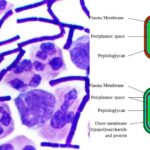Genetics 15 Views 1 Answers
Why is dna replication called semi-conservative?
Why is dna replication called semi-conservative?
Answered
DNA replication is called “semi-conservative” because each of the two new DNA molecules produced contains one original (parental) strand and one newly synthesized strand.
Here’s a breakdown of why this term is used:
- Original Strand Preservation: During replication, the two strands of the original DNA molecule separate. Each original strand serves as a template for the synthesis of a new complementary strand.
- Formation of New Molecules: After replication, each of the two resulting DNA molecules consists of one strand from the original molecule (the “conserved” strand) and one newly synthesized strand. This ensures that the genetic information is accurately preserved and passed on.
The term “semi-conservative” highlights that, unlike a conservative model where the original DNA molecule would remain intact and a completely new molecule would be synthesized, or a dispersive model where both strands would be a mix of old and new, the semi-conservative model preserves half of the original DNA in each new molecule. This model was confirmed by the famous experiment conducted by Matthew Meselson and Franklin Stahl in 1958.
Did this page help you?




